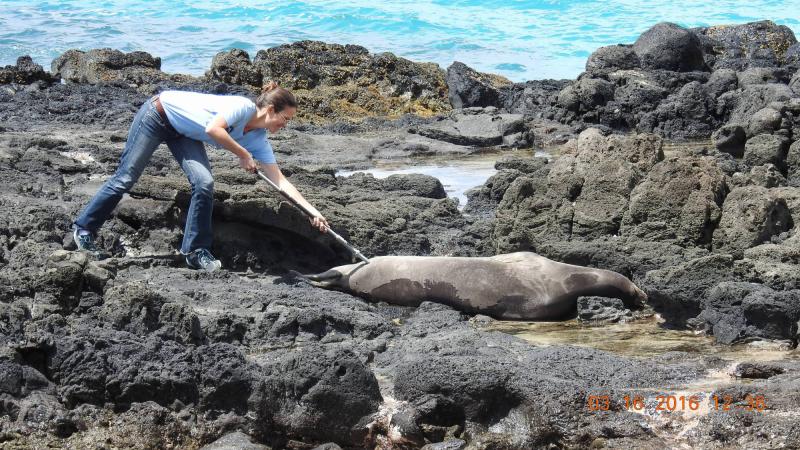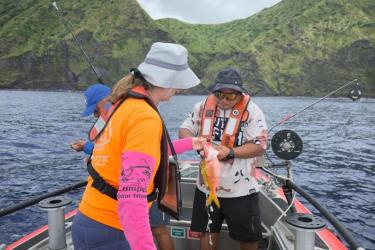On the rocky beaches of the Hawaiian archipelago, a 500-pound Hawaiian monk seal naps peacefully in the sun. A NOAA biologist carefully uses a syringe at the end of a pole to safely vaccinate the seal from a distance with minimal disturbance. The seal barely wakes up from its nap! It is now protected against a potentially fatal disease that has killed tens of thousands of other species of seals around the globe.
NOAA scientists are vaccinating endangered Hawaiian monk seals against a strain of morbillivirus. They’ve completed 700 successful vaccinations—that’s nearly half the population. It’s the world’s first attempt to protect this wild marine mammal from a deadly outbreak.
Once hunted to near extinction, the species is rebounding in part due to long-standing legal protections and ongoing conservation measures. Join us in highlighting the Hawaiian monk seal as we celebrate the 50th anniversary of the Marine Mammal Protection Act and several other laws that protect our oceans and coasts.
Vaccinating Hawaiian Monk Seals Proactively
Hawaiian monk seals are especially vulnerable to disease threats because of their small population size. They are spread across a vast, remote area, making early detection of an outbreak very difficult. Morbillivirus is a highly contagious and lethal group of viruses that include canine distemper and human measles. Outbreaks have killed tens of thousands of seals around the globe. Phocine distemper, the type of morbillivirus that most commonly infects seals, has not yet been detected in Hawaiian monk seals. To proactively protect the species against morbillivirus, scientists launched the first-ever effort to vaccinate a wild marine mammal.
Hawaiian monk seals are vaccinated with a vaccine made for ferrets. After years of research, testing in captive seals, planning, and practice, NOAA scientists and partners vaccinated the first wild Hawaiian monk seal in 2016. Efforts are now focused on protecting pups born each year. They receive their first vaccine during routine flipper tagging and their second vaccine 3–5 weeks later.
Vaccinating seals is not an easy task. Most Hawaiian monk seals live in the Northwestern Hawaiian Islands within the Papahānaumokuākea Marine National Monument. Scientists spend 2–4 months in rugged field camps on the remote islands each summer. In addition to vaccinating Hawaiian monk seals, their work involves:
- Monitoring, tagging and photo documenting the population (abundance, survival rates, etc.)
- Freeing seals from entanglements in marine debris and entrapments in the decaying Tern Island infrastructure
- Treating injuries, rescuing malnourished seals, and reuniting mother-pup pairs
- Translocating weaned pups from shark-populated areas
- Giving deworming medicine to juvenile seals to help rid them of international worms and support healthy growth
This is the 40th year of NOAA’s Hawaiian Monk Seal Research Program. Up to 30 percent of the Hawaiian monk seals are alive today because of the lifesaving efforts of NOAA and our partners. These efforts have no doubt contributed to recent population growth.
About Hawaiian Monk Seals
The Hawaiian monk seal is one of the most endangered seal species in the world. They are native to the Hawaiian archipelago and are found nowhere else on Earth. In Hawaiian, their name is ‘īlio holo i ka uaua, which means “dog that runs in rough water.” Hawaiian monk seals are a part of the biodiversity that make Hawaii’s ocean ecosystem unique.
The overall population had been declining for more than five decades due to historic seal hunting and food limitation. Modern-day threats include entanglement in marine debris, disease, habitat loss, and interactions with humans.
Though the Hawaiian monk seal population has been on the increase in recent years, it is still far below historic levels. Scientists estimate that the population across the Hawaiian archipelago surpassed 1,500 in 2021 for the first time in more than 20 years. The current upward trend is due in part to NOAA Fisheries’ Species in the Spotlight recovery efforts. Federal agencies and our partners are working hard to bring this species back from near extinction.
History of the Hawaiian Monk Seal
Hawaiian monk seals have likely inhabited the entire Hawaiian archipelago for millions of years. Voyaging Polynesians arrived in Hawai‘i in the 1200s, establishing communities in the southern portion of the island chain. Human settlement in this area slowly led to the local extinction of monk seals on the southern islands. The more remote and rarely visited islands to the northwest became the refuge for seals for centuries until the arrival of Europeans in the late 1700s. Then seal hunting and other human activities accelerated the decline of monk seals. A seal hunting expedition by the brig Aiona in 1824 was thought to have killed the last Hawaiian monk seal. But in 1859, an exploratory voyage to the Midway Atoll discovered monk seals on the islands.
Protecting One of the World’s Most Endangered Seals
Since 2013, the Hawaiian monk seal population has been increasing due in part to legal protections.
In 1972, the landmark Marine Mammal Protection Act established a national policy to protect all marine mammals in U.S. waters, including the Hawaiian monk seal. Four years later, the Hawaiian monk seal became the first marine mammal listed under the Endangered Species Act. These monumental Acts set the groundwork for future protections at the national and state levels.
The Northwestern Hawaiian Islands Marine National Monument encompasses key habitat for Hawaiian monk seals in the Northwestern Hawaiian Islands. The Hawaiian monk seal is also the official state mammal of Hawaiʻi and protected under state and federal law.
What Can You Do
We need your help to protect this important species.
- For their protection and your safety, give Hawaiian monk seals space and view them from a distance. Stay at least 50 feet away from Hawaiian monk seals on land and water—use the rule of thumb to determine if you are a safe distance away. Stay at least 150 feet away from mother-pup pairs.
- Keep cats exclusively indoors or safely contained in outdoor enclosures such as catios. Cats that live outdoors can spread the Toxoplasma gondii parasite, which causes the disease toxoplasmosis and is lethal to Hawaiian monk seals and other native wildlife.
- Vaccinate your pets and keep dogs leashed while on beaches where Hawaiian monk seals are present. Dogs have injured and even killed Hawaiian monk seals through attacks and bites, and they can disturb seals resting on the beach. They can also transmit diseases to seals.
- When fishing, if you see a Hawaiian monk seal in the water, bring in your lines until the seal leaves the area.
- Do not feed Hawaiian monk seals (or any other wildlife).
- Please report any seal sightings or human-seal interactions to NOAA Fisheries’ Marine Wildlife Hotline at (888) 256-9840.
With your help we can protect Hawaiian monk seals for future generations to experience. You are our partners in conservation. If you’re lucky enough to see a Hawaiian monk seal on the beach or in the water, be sure to keep your distance and admire from afar.






